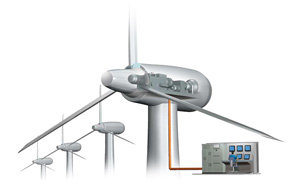
|
Introduction
|
Distributed Energy Resource (DER) systems are small-scale power generation technologies (typically in the range of 3 kW to 10,000 kW) used to provide an alternative to or an enhancement of traditional electric power systems. Wind energy is one of the major power sources for DER, especially for standalone power generators within a smart grid system. One of Taiwan’s leading smart grid projects is working to integrate wind energy systems to develop a complete system
with an excellent cost/performance ratio. They turned to Advantech for a solution which could deliver pitch control, hydraulic system monitoring and wind turbine control.
|

|

|
System Requirements
|
To provide easy maintenance and accessibility through the web, our client needed a dedicated HMI device able to manipulate the wind control system from the tower base and provide real-time monitoring capabilities. Furthermore, the integrator required a reliable and compact PAC controller that could receive wind speed/direction analog signals from an anemometer to direct the nacelle and rotor blade in order to catch the optimal wind direction. They also wanted to program a pitch control algorithm using SoftLogic to slow the blades from moving too fast in the event of high winds or abnormal vibrations from the wind tower. Furthermore the relative devices used in such kind application utilize CANopen as the standard communication protocol, so compatibility with the software was important.

|
Project Implementation
|
|
WebView-1270
|
12.1” Web-enabled HMI with Intel® Celeron® M
|
|
APAX-5521KW
|
Micro PAC with XScale CPU and CAN
|
|
APAX-5017H
|
12-ch High Speed Analog Input Module
|
|
APAX-5013
|
8-ch RTD Module
|
|
APAX-5060
|
12-ch Relay Output Module
|
|
APAX-5045 |
24-ch Digital Input/Output Module |
|
APAX-5080PEC |
3-ch ABZ Encoder Input Module |
|

|
System Description
|
APAX-5521KW combined with APAX I/O modules were integrated into the wind control system to provide optimum control. As a powerful PAC controller with embedded KW SoftLogic, APAX-5521KW is the best platform to provide real-time deterministic execution of complicated pitch control application. Furthermore, it takes advantage of one CANopen interface and one LAN ports to offer communication ability with other devices. The APAX-5080PEC high-speed counter module provides accurately encoded A/B/Z signals from wind yaw and rotor blades. Through APAX-5060, 12 channel relay output can be connected to the hydraulic system to control the yaw and rotor blades.

|
Conclusion
|
Electrical rotor blade adjustment has come to be a standard feature for modern wind energy plants. Not only does it offer significant advantages for the pitching systems, but also ensures the wind turbine operates at optimum yield under all weather conditions. Advantech APAX offers an integrated, scalable and modular control system for this wind turbine control system.

|
System Diagram
|
|